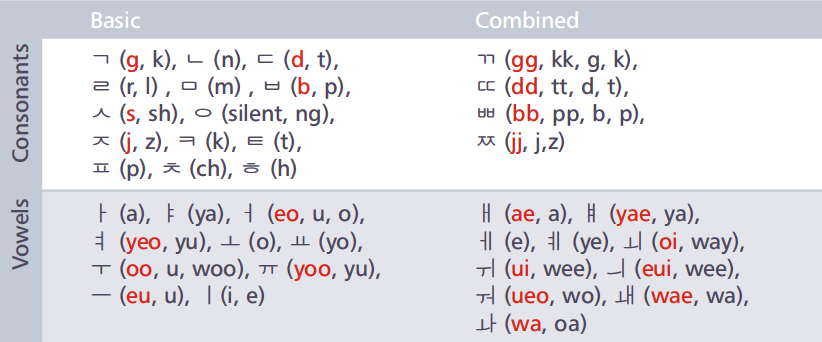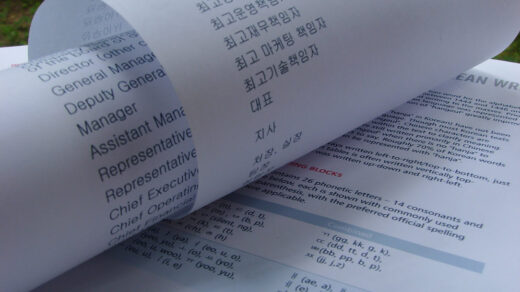This article won’t teach you Korean, but it will give you a framework for understanding the Korean writing system.
TABLE OF CONTENTS
- Letters are the building blocks
- Letters make characters
- Characters make words
- Words make sentences
- Sentence styles vary depending
- About hangul and hanja
- Korean, Japanese and Chinese
Estimated reading time: 6 minutes

Letters are the building blocks of written Korean
The Korean alphabet contains 24 phonetic letters – 14 consonants and 10 vowels. In the table below, each is shown with commonly used English renderings in parenthesis, with the preferred official spelling being expressed in red font where applicable.

Korean letters make characters
Each Korean character is a full syllable made up of at least two letters, one of which is a vowel. Pronunciation generally starts from the left/top-left of the character and trends toward the right/bottom-right.
A syllable can have multiple consonants and basic or combined vowels.

Korean Translation Best Practices Tip: Apparent wording and spelling inconsistencies to a non-Korean speaker may not actually be wrong. It’s a good idea to ask the linguist if you have doubts.
Korean characters make words
Korean is made up of words, just like English. However, there are important differences. In Korean, tags are attached to the ends (or even inserted in the middle) of words to indicate various grammatical cases, honorific relationships or levels of formality. This means that the same word can appear differently in different contexts and grammatical cases.

Furthermore, the spellings of these tags can change depending on the last letter of the previous character. (This is analogous to the English case of “a” and “an”. We say “a computer” or “an apple” depending on the first letter of the next word.)
Korean Translation Best Practices Tip: You cannot just do a reckless global find-and-replace through a Korean document to change a term. Adjacent characters may also need to be revised, too.
Korean words make sentences
The grammatical structure of Korean is radically different than English. In many cases, when translating between the languages, it almost seems like you have to start at the end of a sentence and translate backward in order to produce a proper sentence in the target language.

In the following example, each word has been linked to its equivalent in the other language to demonstrate how non-linear the relationship is between English and Korean.

Korean Translation Best Practices Tip: Do not, under any circumstances, divide an English sentence into two parts and ask that each half be translated into Korean independently (or vice-versa!) Because of the dramatically different grammatical structures, this will often lead to non-sensical translations.
Korean sentence styles vary depending on the situation
The concepts of formality and respect are well-developed in Korean. This is one of the most difficult issues for foreigners to fully master when learning Korean. There are multiple sentence ending styles depending on the type of document and the relationships between the writer/speaker and reader/listener.
The following examples show several ways of translating the present tense of the verb “translate”. All have the same meaning but different connotations of formality and respect. The examples in the left box tend to be used in written Korean, while those in the right box are more common in spoken Korean.

Korean Translation Best Practices Tip: Look for consistency of endings in Korean paragraphs. They don’t all end the same way, but many do and a single documents should use the same level of formality throughout, except in special circumstances.
About hangul and hanja
“Hangeul” (also spelled “hangul”) is the Korean word for the alphabet invented in Korea by a group of scholars between 1444 and 1446 on the order of King Sejong to bring reading and writing to the masses. Prior to the development of “hangeul”, the Korean language was represented using Chinese characters, so the invention of “hangeul” greatly improved literacy.
However, Chinese characters (called “hanja” in Korean) have not been completely eliminated from the language. Though most Korean texts today are written exclusively in “hangeul”, Chinese characters are occasionally added in parenthesis within the text to clarify meaning.
Even today, a few erudite texts are still written primarily in Chinese characters interspersed with “hangeul” when there is no “hanja” to represent what the writer wants to say. Roughly 70% of Korean words have a Chinese origin which can be represented with “hanja”.
Modern Korean is almost always written left-to-right/top-to-bottom, just like English. However, text in tables is often written vertically top-to- bottom. Classical Korean was written up-to-down and right-to-left.
Comparison between Korean, Japanese, and Chinese
There are many similaries between Korean and Japanese in terms of word order, grammar and origin so a lot of what you have heard about Japanese probably applies to Korean, too.
“Hangul” and “hanja” are to Korean what “kana” and “kanji” are to Japanese. However, there are important differences. Far less “hanja” is used in Korean than “kanji” in Japanese and phonetic rules of “hangul” are completely unrelated to the structure of “kana”. Furthermore, the “kanji” of Japan mostly uses simplified Chinese characters, whereas Korean “hanja” uses traditional Chinese characters.
Structurally, Korean and Chinese are very different. Korean makes some use of Chinese characters and many Korean words are of Chinese origin, but the grammar and style are totally different.
Unlike Chinese and Japanese which do not insert spacing within the text, Korean has a well-developed concept of words and inter-word spacing.


